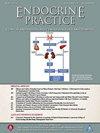Bilateral Adrenal Nodules Presenting With Mild Autonomous Cortisol Secretion
IF 4.6
3区 医学
Q2 ENDOCRINOLOGY & METABOLISM
引用次数: 0
Abstract
Objective
Benign adrenocortical adenomas are frequently diagnosed on cross-sectional imaging performed for unrelated reasons. Up to 15% to 20% of adrenal nodules are bilateral, representing bilateral adenomas or primary bilateral macronodular adrenal hyperplasia.
Methods
Mild autonomous cortisol secretion (MACS), diagnosed based on an abnormal dexamethasone suppression test, is seen in 19% to 44% of patients with adrenal adenomas. Distinguishing unilateral from bilateral MACS in patients with bilateral nodules is important to guide appropriate therapy and relies on imaging phenotype, and, in some cases, on adrenal vein sampling.
Results
MACS is associated with cardiovascular morbidity, poor quality of life, frailty, and increased mortality. Reversal of MACS improves these outcomes; however, management of patients with bilateral MACS is challenging. Unilateral adrenalectomy in patients with bilateral nodules and MACS may lead to permanent remission (if MACS is unilateral), temporary remission, or improvement of the degree of MACS (if MACS is bilateral). No medical therapy is currently approved for MACS.
Conclusion
Here, we review the presentation, diagnosis, and management of patients with bilateral adrenal nodules and MACS.
双侧肾上腺结节表现为轻度自主皮质醇分泌。
良性肾上腺皮质腺瘤经常被诊断为横断成像进行无关的原因。高达15-20%的肾上腺结节是双侧的,代表双侧腺瘤或原发性双侧肾上腺大结节性增生。轻度自主皮质醇分泌(MACS),根据异常地塞米松抑制试验诊断,见于19-44%的肾上腺腺瘤患者。区分双侧结节患者的单侧MACS和双侧MACS对于指导适当的治疗非常重要,并依赖于影像学表型,在某些情况下,还需要肾上腺静脉采样。MACS与心血管疾病、生活质量差、虚弱和死亡率增加有关。MACS的逆转改善了这些结果,然而,双侧MACS患者的管理是具有挑战性的。双侧结节和MACS患者的单侧肾上腺切除术可能导致永久性缓解(如果MACS是单侧),暂时缓解或MACS程度的改善(如果MACS是双侧)。目前还没有批准用于MACS的药物治疗。在此,我们回顾双侧肾上腺结节和MACS患者的表现、诊断和治疗。
本文章由计算机程序翻译,如有差异,请以英文原文为准。
求助全文
约1分钟内获得全文
求助全文
来源期刊

Endocrine Practice
ENDOCRINOLOGY & METABOLISM-
CiteScore
7.60
自引率
2.40%
发文量
546
审稿时长
41 days
期刊介绍:
Endocrine Practice (ISSN: 1530-891X), a peer-reviewed journal published twelve times a year, is the official journal of the American Association of Clinical Endocrinologists (AACE). The primary mission of Endocrine Practice is to enhance the health care of patients with endocrine diseases through continuing education of practicing endocrinologists.
 求助内容:
求助内容: 应助结果提醒方式:
应助结果提醒方式:


